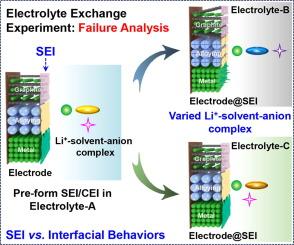Electrolyte exchange experiment in batteries: Failure analysis and prospect
IF 14.9
1区 化学
Q1 Energy
引用次数: 0
Abstract
The solid electrolyte interphase (SEI) layer, formed on the electrode through electrolyte decomposition, has garnered significant attention over the past several decades. Numerous characterization studies have shown that the SEI enhances the stability of both the electrolyte and electrode, particularly by mitigating the well-known cation-solvent co-intercalation in graphite electrodes in lithium-ion batteries. However, recent electrolyte exchange experiments have revealed that variations in electrolyte solvation structure and the resulting desolvation behaviors play a more dominant role than the SEI in influencing electrolyte and electrode stability, which in turn critically impacts battery performance. In addition to contributing to the ongoing debate, electrolyte exchange experiments have proven to be a valuable tool for analyzing failures in electrolytes, electrodes, and batteries. This review highlights the application of electrolyte exchange experiments across various metal-ion batteries, incorporating diverse combinations of electrolytes and electrodes. It examines the influence of electrolyte solvation structures and desolvation behaviors on the stability of both electrolytes and electrodes. The aim is to enhance the methodology of electrolyte exchange experiments to deepen the understanding of the molecular interactions among metal ions, anions, and solvents within the electrolyte. This approach complements existing insights into SEI effects, providing a more thorough and accurate framework for battery failure analysis.

电池电解液交换实验:失效分析与展望
在过去的几十年里,通过电解质分解在电极上形成的固体电解质间相(SEI)层引起了人们的极大关注。大量的表征研究表明,SEI增强了电解质和电极的稳定性,特别是通过减轻锂离子电池石墨电极中众所周知的阳离子-溶剂共插层。然而,最近的电解质交换实验表明,电解质溶剂化结构的变化以及由此产生的脱溶行为在影响电解质和电极稳定性方面比SEI起着更重要的作用,而这反过来又对电池的性能产生关键影响。电解质交换实验已被证明是分析电解质、电极和电池故障的一种有价值的工具。本文综述了电解质交换实验在各种金属离子电池中的应用,包括不同的电解质和电极组合。研究了电解质溶剂化结构和脱溶行为对电解质和电极稳定性的影响。目的是提高电解质交换实验的方法,以加深对电解质中金属离子、阴离子和溶剂之间分子相互作用的理解。这种方法补充了对SEI效应的现有见解,为电池故障分析提供了更全面、更准确的框架。
本文章由计算机程序翻译,如有差异,请以英文原文为准。
求助全文
约1分钟内获得全文
求助全文
来源期刊

Journal of Energy Chemistry
CHEMISTRY, APPLIED-CHEMISTRY, PHYSICAL
CiteScore
19.10
自引率
8.40%
发文量
3631
审稿时长
15 days
期刊介绍:
The Journal of Energy Chemistry, the official publication of Science Press and the Dalian Institute of Chemical Physics, Chinese Academy of Sciences, serves as a platform for reporting creative research and innovative applications in energy chemistry. It mainly reports on creative researches and innovative applications of chemical conversions of fossil energy, carbon dioxide, electrochemical energy and hydrogen energy, as well as the conversions of biomass and solar energy related with chemical issues to promote academic exchanges in the field of energy chemistry and to accelerate the exploration, research and development of energy science and technologies.
This journal focuses on original research papers covering various topics within energy chemistry worldwide, including:
Optimized utilization of fossil energy
Hydrogen energy
Conversion and storage of electrochemical energy
Capture, storage, and chemical conversion of carbon dioxide
Materials and nanotechnologies for energy conversion and storage
Chemistry in biomass conversion
Chemistry in the utilization of solar energy
 求助内容:
求助内容: 应助结果提醒方式:
应助结果提醒方式:


